Earlier today the United States Patent and Trademark Office held a public form on subject matter eligibility on the USPTO campus in Alexandria, Virginia. Drew Hirshfeld, Deputy Commissioner for Patent Examination Policy, provided opening remarks. Hirshfeld began by apologizing for the absence of Michelle Lee who was not at the Forum due to the Senate Judiciary Committee scheduling her second confirmation hearing for this afternoon.
Hirshfeld went over the highlights of the USPTO interim guidance, explaining “first, we were able to narrow the funnel that we use to determine which claims should be analyzed for subject matter eligibility.” In this regard Hirshfeld was discussing how the USPTO modified the proposed guidance, which was initially released for comment and the guidance that was release in December 2014. In the proposed guidance from March 2014, the USPTO would have had examiners apply the patent eligibility matrix if the claims “recited or involved” a judicial exception to patent eligibility. In the final guidance, Hirshfeld explained, that the USPTO opted for “directed to” language instead, which is narrower than the expansive “recited or involved” standard.
Hirshfeld also explained that the feedback the USPTO continues to receive is predominantly asking for more examples, and he indicated a willingness and desire to provide additional examples moving forward.
According to Hirshfeld, the immediate next step will be to train examiners. Hirshfeld recognized receiving feedback from stakeholders complaining that patent examiners are simply not following the USPTO guidance. Hirshfeld pointed out that the final guidance was released as soon as it was ready and that examiners had not yet been trained on the guidance. This training will continue in earnest, but it will take some time. The USPTO is “at the beginning of [the training] process right now.”
Obviously, examiners not following this interim guidance is problematic and concerning, but at the same time it is understandable to some extent that the USPTO needs time to train examiners. The real test, in my opinion, will be whether the USPTO can get recalcitrant patent examiners to follow the guidance even after they are trained. It is not news to anyone that at least some, perhaps many, examiners in certain Art Units simply refuse to issue patents and refuse to follow the guidance they receive from senior Office leaders.
[Bio-Pharma]
Hirshfeld also explained that this will be an iterative process, but that the guidance is “a step in the right direction, although more is needed.” Hirshfeld explained that the USPTO will continue to monitor case law, and looks forward to receiving additional comments, which are due by March 16, 2015. Hirshfeld also explained that the USPTO doesn’t believe that limiting examples to what can be learned from specific decisions will not sufficient, at least in the short-term given that there is a limit to the number of cases that can provide guidance. Therefore, the USPTO will be providing more examples, including abstract idea hypotheticals. Hirshfeld said that these abstract idea hypotheticals likely in a matter of days, not weeks, which suggests that the hypotheticals have been written and are in the final editing process. During the question and answer period at the end Hirshfeld explained that he had hoped the hypotheticals and examples would be published before the forum, but that wasn’t possible. He did point out that they will be provided in ample time for the industry to provide comments prior to the March 2015 comment deadline.
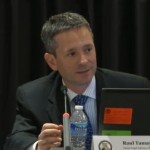 Raul Tamayo (pictured right), Senior Legal Advisor in the Office of Patent Legal Administration, walked through the USPTO guidance, focusing on the flowchart contained within the guidance that defines the subject matter eligibility test that will be applied by patent examiners. Before jumping into the details Tamayo explained that the December 2014 interim guidance on eligibility supplements the June 25, 2014 preliminary instructions provided to patent examiners in the wake of the Supreme Court’s decision in Alice, but that it supersedes the March 4, 2014, subject matter eligibility analysis. Tamayo also explained that there are no bright lines between the exceptions and that many claims can and will fall under more than one judicial exception to patent eligibility.
Raul Tamayo (pictured right), Senior Legal Advisor in the Office of Patent Legal Administration, walked through the USPTO guidance, focusing on the flowchart contained within the guidance that defines the subject matter eligibility test that will be applied by patent examiners. Before jumping into the details Tamayo explained that the December 2014 interim guidance on eligibility supplements the June 25, 2014 preliminary instructions provided to patent examiners in the wake of the Supreme Court’s decision in Alice, but that it supersedes the March 4, 2014, subject matter eligibility analysis. Tamayo also explained that there are no bright lines between the exceptions and that many claims can and will fall under more than one judicial exception to patent eligibility.
When beginning to address the flow chart, which he said was perhaps “the best overview of all,” Tamayo explained “one of our main goals as we developed the interim guidance was to structure our test in a manner that would minimize the instances in which the analysis needed to proceed all the way down to the second part of step 2, and we believe we have accomplished that.” The importance of this statement should not go unnoticed. The analysis would not need to proceed all the way down to the second part of the test, step 2B, if and only if that patent claim were deemed patent eligible as the result of step 1 or step 2A. Therefore, philosophically the USPTO seems to have tried to work to create a test that conceptually offers applicants and patent practitioners guidance on how to draft claims to cover patent eligible inventions, leaving only those claims that are specifically directed to nothing more than a judicial exception as those that will be patent ineligible.
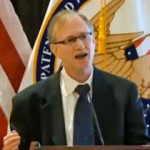 Despite the explained wishes from USPTO senior management, Clark Jablon (pictured right), a partner with Panitch, Schwarze Belisario & Nadel, explained during his comments that examiners have told him that they are being trained to conduct a complete Mayo analysis. Jablon explained: “they are being trained to ignore the streamlined eligibility analysis for software inventions and to always perform the full Mayo analysis under the reasoning that there is always some doubt a judicial exception is being preempted in software cases.” What Jablon says is hardly surprising. For years many patent examiners have done whatever they want and ignore USPTO guidance, training and direction. The real question isn’t whether the interim guidance is correct, or whether any further provided hypotheticals and examples will be informing. Instead, the real question will be whether the USPTO can actually get examiners to follow the guidance and apply the law and rules the way they are told. History suggests that at least some, perhaps many, patent examiners will simply ignore the USPTO, thereby forcing applicants to either abandon applications or fight in a lengthy and expensive appeals process.
Despite the explained wishes from USPTO senior management, Clark Jablon (pictured right), a partner with Panitch, Schwarze Belisario & Nadel, explained during his comments that examiners have told him that they are being trained to conduct a complete Mayo analysis. Jablon explained: “they are being trained to ignore the streamlined eligibility analysis for software inventions and to always perform the full Mayo analysis under the reasoning that there is always some doubt a judicial exception is being preempted in software cases.” What Jablon says is hardly surprising. For years many patent examiners have done whatever they want and ignore USPTO guidance, training and direction. The real question isn’t whether the interim guidance is correct, or whether any further provided hypotheticals and examples will be informing. Instead, the real question will be whether the USPTO can actually get examiners to follow the guidance and apply the law and rules the way they are told. History suggests that at least some, perhaps many, patent examiners will simply ignore the USPTO, thereby forcing applicants to either abandon applications or fight in a lengthy and expensive appeals process.
Tamayo also spent time discussing the all important term “directed to,” explaining that the USPTO moved to this language in part as the result of the Supreme Court’s decision in Alice. Tamayo went on to say that a claim will be “directed to” a judicial exception when “the exception recited in the claim.” He explained that the language courts have used phrase the inquiry in this way: “does it set forth or set forth the exception?”
Tamayo explained that patent examiners should not be providing any office actions that only include patent eligibility rejections. Tamayo explained that nothing in the patent eligibility guidance does anything to change the principles of compact prosecution. Examiners are still instructed to provide a full examination and move forward to 102, 103 and 112 even if the claims are found to be patent ineligible under 101.
If the answer is step 2A is no then the claim is patent eligible. Only when the answer to question 2A is yes will the examiner move forward to part 2 of the Mayo test. The USPTO guidance explains that “a claim is directed to a judicial exception when a law of nature, a natural phenomenon, or an abstract idea is recited (i.e., set forth or described) in the claim.”
With respect to nature-based products one of the keys is to determine whether there are “markedly different characteristics.” The guidance explains that “a claim that recites a nature-based product limitation that does not exhibit markedly different characteristics from its naturally occurring counterpart in its nature state is directed to a product of nature exception.”
If the analysis under step 2A results in a finding that the claim is directed to a judicial exception then and only then will patent examiners proceed to step 2B of the Mayo test. Step 2B is where patent examiners will determine whether an element or combination of elements within the claim are sufficient to ensure that the claim amounts to significantly more than merely covering one of the recognized judicial exceptions to patent eligibility. Where the claim recites significantly more than a claim to a judicial exception itself, the claim is patent eligible.
As with any public forum held by the USPTO, members of the public were invited to present their opinions and views. In order to be allocated time one had to submit a request to the USPTO in advance. The USPTO then allocates time until all slots have been filled.
With respect to those who spoke about software and the abstract idea exception there was near unanimous agreement that more examples are required because in practice it is virtually impossible to figure out whether a claim covers an abstract idea under the current guidance. In fact, Micky Minhas, who is Associate General Counsel for Microsoft, pointed out that earlier today in an interview with a patent examiner the examiner readily admitted that he had no idea how to define an abstract idea. That, of course, is hardly surprising given that the Supreme Court has never defined the term “abstract idea,” despite having a doctrine and line of cases purporting to apply the abstract idea exception to patent eligibility. For the life of me I will never understand how under our system of justice, or any system of justice that allegedly seeks to be fair and evenhanded, there can be an undefined legal test applied to determine whether or not a property right exists.
In any event, what follows are highlights from several of those who spoke at the forum earlier today.
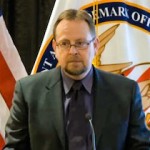 Hans Sauer
Hans Sauer
Deputy General Counsel
Biotechnology Industry Organization
“BIO’s members continue to be concerned with patentability in the United States. Few areas of substantive patent law have received as much discussion within BIO’s membership. BIO’s members view the development of extra statutory law in this area as a significant departure from internationally accepted norms of patentability with negative implications for innovative, industrial, agricultural and pharmaceutical products and processes. Inventive preparations based on naturally occurring substances have historically been of great importance in biotechnology and innovation in this area has been spurred by, at least in part, by the availability of patent protection. This is true for every sector of biotechnology; examples include vaccine antigens, crop protection products, plant biotechnology, industrial enzymes, immunosuppressants, anti-cancer substances and antibiotic drugs.”
Sauer then went on to explain exactly why this matters so much. Sauer pointed to recent news of a groundbreaking antibiotic that was found in soil, and which could be the answer to cure previously curable conditions that now once again kill due to antibiotic resistance. Sauer pointed out that in the news coverage heralding the discovery it was not pointed out that the Patent Office has rejected the molecule as patent ineligible.
Sauer did not connect the dots directly in the limited time he was afforded, undoubtedly because everyone in attendance knows what this story means. Allow me to come right out and state the obvious. If the patent eligibility rejection of this revolutionary antibiotic persists and patent protection cannot be obtained this extraordinary discover will not benefit anyone. Without patent protection it will not be financially feasible to undertake the extraordinary expense of research, development and deployment into the marketplace. Simply stated, without patent protection the extreme expense of taking drugs to market will not be undertaken.
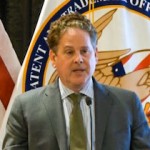 Bob Stoll
Bob Stoll
Partner, DrinkerBiddle
Former Commissioner for Patents
Speaking on behalf of the Partnership for American Innovation, Stoll said:
“Turning to Alice, let’s start with the elephant in the room. The Supreme Court’s unanimous ruling in Alice did not comment on the eligibility of software. Instead, the Alice patent was understood by the Court as a business method patent that essentially preempted an age old business practice, but the message subtly conveyed about software, namely that software as a class is every bit as worthy of patent protection as any other medium in which innovation can be practiced is important as its guidance on these method patents. The USPTO general interpretation in the Alice guidelines accurately and closely follows the narrow Alice ruling. Yet there seems to be anecdotal evidence that suggests additional clarity and examples to provide guidance on how to correctly apply the test would further improve the guidance from the PTO. We encourage the USPTO to expand upon the preliminary guidelines and promulgate rules between the much needed predictability for the patent community and flexibility to embrace all fields of invention… Currently there is some ambiguity on how to apply part 1 of the Mayo test, particular dealing with ‘certain methods of organizing human activity.’ Supreme Court case law clearly states that method for organizing human activities are not a separate basis for identifying an abstract idea. The PTO guidance recognizes this distinction by stating that that only certain methods of organizing human activities encompass abstract ideas. However, in practice, this nuance is sometimes ignored or incorrectly or inconsistently applied. Clarifying how to identify abstract ideas, which have relatively narrow definitions… would provide additional clarity and certainty for patent applicants and insure that the guidelines conform to the case law.”
 Jim Crowne
Jim Crowne
Deputy Executive Director for Legal Affairs
American Intellectual Property Law Association
“The Court has repeatedly noted that all inventions at some level embody, use, reflect, rest upon or apply laws of nature, natural phenomenon or abstract ideas, and that too broad an interpretation of this exclusionary principle could eviscerate patent law. So what is required, we believe, is that there be an understanding of when a claim transitions from the mere recitation of one of these excluded categories into an application of them that is useful and does not tie up basic technological principles.”
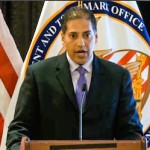 Micky Minhas
Micky Minhas
Associate General Counsel
Microsoft Corporation
“We believe that the guidelines would benefit from additional clarity and guidance on how to apply and understand the existing case law. Applying these precedents carefully is critically important to stifling innovations in the field of computing technologies, which are one of the most important industries to our economy and the future of innovation. The patent eligibility exceptions are judicially created exceptions to an otherwise broad statutory grant to patent eligibility under 101. We agree [with previous] remarks that these exceptions be narrowly construed per the Supreme Court’s precedents. There are a number of cases that have been decided by the Supreme Court based on the abstract idea exception. Some of these cases involve the use of computers and computing, such as Benson, Flook and Diehr back in the 70s and 80s and other more recent Bilski and Alice decisions, which are focused more on business processes. However, the main inventive concepts covered by these cases are directed either to mathematical algorithms or fundamental economic practices that have been around for a long time or high level fundamental ideas such as mathematical or scientific truths. The patent eligibility case law, when properly applied, should not prevent an innovative computing invention from being patent ineligible simply because it references a computer. In fact, the Alice decision explicitly indicates that the functioning of the computer itself can provide the ‘something more’ that transforms an unpatentable abstract idea into a practical application of that idea that is eligible for patent protection. Accordingly, we believe the examining corps should be trained to consider improvements in both software and hardware when determining whether computing limitations that provide the ‘something more’ that imparts patent eligibility. After all, whether to implement a novel algorithm or innovation through hardware or software or firmware is often a design choice and that design choice of how to implement an innovation should be irrelevant to the question of patent eligibility.”

![[IPWatchdog Logo]](https://ipwatchdog.com/wp-content/themes/IPWatchdog%20-%202023/assets/images/temp/logo-small@2x.png)

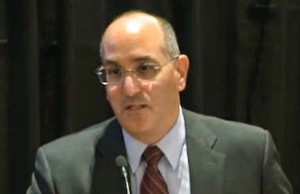
![[Advertisement]](https://ipwatchdog.com/wp-content/uploads/2024/04/Patent-Litigation-Masters-2024-sidebar-early-bird-ends-Apr-21-last-chance-700x500-1.jpg)

![[Advertisement]](https://ipwatchdog.com/wp-content/uploads/2021/12/WEBINAR-336-x-280-px.png)
![[Advertisement]](https://ipwatchdog.com/wp-content/uploads/2021/12/2021-Patent-Practice-on-Demand-recorded-Feb-2021-336-x-280.jpg)
![[Advertisement]](https://ipwatchdog.com/wp-content/uploads/2021/12/Ad-4-The-Invent-Patent-System™.png)







Join the Discussion
3 comments so far.
Anon
January 22, 2015 10:31 amTo mirror Clark Jablon’s comment (which is diametrically opposed by Mr. Stoll’s apparently wishful thinking), and to fold into the equation the ongoing saga of the SAWS debacle, I note that one of the categories of “embarrassment” that is super-broadly listed is “business method patents.”
Is this like the Court’s “abstract?” Is there some additional (still hidden) details here of what “business method” means so as to warrant extra attention and special handling?
Or do we have factions of the legal system there to promote innovation that are simply running amuck, out of sight and out of control?
Stuart Graham
January 22, 2015 06:36 amThanks Gene for the useful community service in doing a nice job summarizing the discussion for those of us who could not be there.
Paul Cole
January 22, 2015 05:27 amCongratulations on getting out a report on this important event with such speed.
Unfortunately although the USPTO no longer believes that gunpowder is naturally occurring, there are still problems with the approachh and especially with the examples given for natural products.